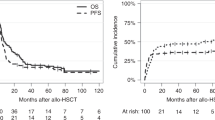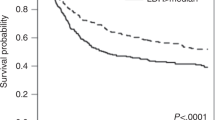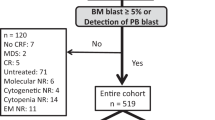Abstract
Prognostic biomarkers are useful in allogeneic stem cell transplantation (SCT) to predict survival and relapse outcomes. We sought to derive a prognostic scoring system, which augmented the predictive power of the disease risk index (DRI) by incorporating biomarkers and validating their significance after SCT. The outcomes of overall survival (OS) and relapse were assessed with non-relapse mortality (NRM) treated as a competing risk to relapse. Six hundred and two patients were identified through a retrospective analysis of allogeneic SCT recipients for haematological malignancy between 2000 and 2013 in a single centre. Multivariate analysis confirmed the significant predictors of OS pre-SCT were serum ferritin >1000 μg/L (hazard ratio (HR) 1.94, 95% comorbidity index (CI): 1.44–2.60), Hb <100 g/L (HR 1.71, 95% CI: 1.27–2.30) and albumin <30 g/L (HR 2.65, 95% CI: 1.30–5.40). In combination with DRI, these biomarkers significantly improved the Harrell’s C statistic (excluding biomarkers: C=0.60, 95% CI: 0.57–0.64; with biomarkers: C=0.65, 95% CI: 0.62–0.69, P<0.001). Four prognostic groups were derived at the pre-SCT time point: Group 1 (Scores 0–1, n=180, HR=1 (ref)), Group 2 (Scores 2–5, n=298, HR 2.7, 95% CI: 1.8–3.9), Group 3 (Scores 6–7, n=87, HR 4.5, 95% CI: 3.0–6.9) and Group 4 (scores 8–10, n=9, HR 13.4, 95% CI: 5.9–30.2). These prognostic models were also predictive of relapse and NRM and remained valid at day 100, 12 months and 24 months post SCT.
This is a preview of subscription content, access via your institution
Access options
Subscribe to this journal
Receive 12 print issues and online access
$259.00 per year
only $21.58 per issue
Buy this article
- Purchase on Springer Link
- Instant access to full article PDF
Prices may be subject to local taxes which are calculated during checkout




Similar content being viewed by others
References
Armand P, Gibson CJ, Cutler C, Ho VT, Koreth J, Alyea EP et al. A disease risk index for patients undergoing allogeneic stem cell transplantation. Blood 2012; 120: 905–913.
Armand P, Kim HT, Logan BR, Wang Z, Alyea EP, Kalaycio ME et al. Validation and refinement of the Disease Risk Index for allogeneic stem cell transplantation. Blood 2014; 123: 3664–3671.
Lim AB, Roberts AW, Mason K, Bajel A, Szer J, Ritchie DS . Validating the allogeneic stem cell transplantation disease risk index: sample size, follow-up, and local data are important. Transplantation 2015; 99: 128–132.
Kataoka K, Nannya Y, Hangaishi A, Imai Y, Chiba S, Takahashi T et al. Influence of pretransplantation serum ferritin on nonrelapse mortality after myeloablative and nonmyeloablative allogeneic hematopoietic stem cell transplantation. Biol Blood Marrow Transplant 2009; 15: 195–204.
Wermke M, Schmidt A, Middeke JM, Sockel K, von Bonin M, Schonefeldt C et al. MRI-based liver iron content predicts for nonrelapse mortality in MDS and AML patients undergoing allogeneic stem cell transplantation. Clin Cancer Res 2012; 18: 6460–6468.
Bazuaye GN, Buser A, Gerull S, Tichelli A, Stern M . Prognostic impact of iron parameters in patients undergoing allo-SCT. Bone Marrow Transplant 2012; 47: 60–64.
Meyer SC, O'Meara A, Buser AS, Tichelli A, Passweg JR, Stern M . Prognostic impact of posttransplantation iron overload after allogeneic stem cell transplantation. Biol Blood Marrow Transplant 2013; 19: 440–444.
Tachibana T, Tanaka M, Numata A, Matsumoto K, Tomita N, Fujimaki K et al. Clinical significance of pre- and 1-year post-transplant serum ferritin among adult transplant recipients. Leuk Lymphoma 2014; 55: 1350–1356.
Tachibana T, Tanaka M, Yamazaki E, Numata A, Takasaki H, Kuwabara H et al. Multicenter validation of scoring system of pre-transplant serum ferritin and disease risk in patients with acute myeloid leukemia and myelodysplastic syndrome after allogeneic hematopoietic stem cell transplant. Leuk Lymphoma 2013; 54: 1318–1320.
Vaughn JE, Storer BE, Armand P, Raimondi R, Gibson C, Rambaldi A et al. Design and validation of an augmented hematopoietic cell transplantation-comorbidity index comprising pretransplant ferritin, albumin, and platelet count for prediction of outcomes after allogeneic transplantation. Biol Blood Marrow Transplant 2015; 21: 1418–1424.
Artz AS, Logan BR, Zhu X, Akpek G, Martino R, Gupta V et al. Pre-transplant C-reactive protein (CRP), ferritin and albumin as biomarkers to predict transplant related mortality (TRM) after allogeneic hematopoietic cell transplant (HCT). Blood (ASH Annual Meeting Abstracts) 2014; 124: 422.
Fine JP, Gray RJ . A proportional hazards model for the subdistribution of a competing risk. J Am Stat Assoc 1999; 94: 496–509.
Harrell FE Jr, Califf RM, Pryor DB, Lee KL, Rosati RA . Evaluating the yield of medical tests. JAMA 1982; 247: 2543–2546.
Harrell FE Jr, Lee KL, Mark DB . Multivariable prognostic models: issues in developing models, evaluating assumptions and adequacy, and measuring and reducing errors. Stat Med 1996; 15: 361–387.
Armand P, Kim HT, Rhodes J, Sainvil MM, Cutler C, Ho VT et al. Iron overload in patients with acute leukemia or MDS undergoing myeloablative stem cell transplantation. Biol Blood Marrow Transplant 2011; 17: 852–860.
Vag T, Kentouche K, Krumbein I, Reichenbach JR, Lopatta E, Renz DM et al. Noninvasive measurement of liver iron concentration at MRI in children with acute leukemia: initial results. Pediatr Radiol 2011; 41: 980–984.
Trottier BJ, Burns LJ, DeFor TE, Cooley S, Majhail NS . Association of iron overload with allogeneic hematopoietic cell transplantation outcomes: a prospective cohort study using R2-MRI-measured liver iron content. Blood 2013; 122: 1678–1684.
Armand P, Kim HT, Virtanen JM, Parkkola RK, Itala-Remes MA, Majhail NS et al. Iron overload in allogeneic hematopoietic cell transplantation outcome: a meta-analysis. Biol Blood Marrow Transplant 2014; 20: 1248–1251.
Grossekatthofer M, Guclu ED, Lawitschka A, Matthes-Martin S, Mann G, Minkov M et al. Ferritin concentrations correlate to outcome of hematopoietic stem cell transplantation but do not serve as biomarker of graft-versus-host disease. Ann Hematol 2013; 92: 1121–1128.
Busca A, Falda M, Manzini P, D'Antico S, Valfre A, Locatelli F et al. Iron overload in patients receiving allogeneic hematopoietic stem cell transplantation: quantification of iron burden by a superconducting quantum interference device (SQUID) and therapeutic effectiveness of phlebotomy. Biol Blood Marrow Transplant 2010; 16: 115–122.
Gupta D, Lis CG . Pretreatment serum albumin as a predictor of cancer survival: a systematic review of the epidemiological literature. Nutr J 2010; 9: 69.
Nazha B, Moussaly E, Zaarour M, Weerasinghe C, Azab B . Hypoalbuminemia in colorectal cancer prognosis: nutritional marker or inflammatory surrogate? World J Gastrointest Surg 2015; 7: 370–377.
Deeg HJ, Seidel K, Bruemmer B, Pepe MS, Appelbaum FR . Impact of patient weight on non-relapse mortality after marrow transplantation. Bone Marrow Transplant 1995; 15: 461–468.
Hoffmeister PA, Storer BE, Macris PC, Carpenter PA, Baker KS . Relationship of body mass index and arm anthropometry to outcomes after pediatric allogeneic hematopoietic cell transplantation for hematologic malignancies. Biol Blood Marrow Transplant 2013; 19: 1081–1086.
Scott BL, Park JY, Deeg HJ, Marr KA, Boeckh M, Chauncey TR et al. Pretransplant neutropenia is associated with poor-risk cytogenetic features and increased infection-related mortality in patients with myelodysplastic syndromes. Biol Blood Marrow Transplant 2008; 14: 799–806.
Robin M, Tabrizi R, Mohty M, Furst S, Michallet M, Bay JO et al. Allogeneic haematopoietic stem cell transplantation for myelofibrosis: a report of the Societe Francaise de Greffe de Moelle et de Therapie Cellulaire (SFGM-TC). Br J Haematol 2011; 152: 331–339.
Deeg HJ, Scott BL, Fang M, Shulman HM, Gyurkocza B, Myerson D et al. Five-group cytogenetic risk classification, monosomal karyotype, and outcome after hematopoietic cell transplantation for MDS or acute leukemia evolving from MDS. Blood 2012; 120: 1398–1408.
Kew AK, Clarke S, Ridler A, Burrell S, Edwards JA, Doucette S et al. A prospective cohort study of the feasibility and efficacy of iron reduction by phlebotomy in recipients of hematopoietic SCT. Bone Marrow Transplant 2015; 50: 457–458.
Author information
Authors and Affiliations
Corresponding author
Ethics declarations
Competing interests
The authors declare no conflict of interest.
Additional information
Supplementary Information accompanies this paper on Bone Marrow Transplantation website
Supplementary information
Rights and permissions
About this article
Cite this article
Chee, L., Tacey, M., Lim, B. et al. Pre-transplant ferritin, albumin and haemoglobin are predictive of survival outcome independent of disease risk index following allogeneic stem cell transplantation. Bone Marrow Transplant 52, 870–877 (2017). https://doi.org/10.1038/bmt.2017.51
Received:
Revised:
Accepted:
Published:
Issue Date:
DOI: https://doi.org/10.1038/bmt.2017.51
This article is cited by
-
Pretransplantation predictors of survival in nonremission acute myeloid leukemia treated with haploidentical transplantation using steroid-based GVHD prophylaxis
Annals of Hematology (2024)
-
HCT frailty scale for younger and older adults undergoing allogeneic hematopoietic cell transplantation
Bone Marrow Transplantation (2023)
-
Impact of hematopoietic cell transplant frailty scale on transplant outcome in adults
Bone Marrow Transplantation (2023)
-
Pilot prospective study of Frailty and Functionality in routine clinical assessment in allogeneic hematopoietic cell transplantation
Bone Marrow Transplantation (2021)
-
Haemophagocytic lymphohistiocytosis (HLH) following allogeneic haematopoietic stem cell transplantation (HSCT)—time to reappraise with modern diagnostic and treatment strategies?
Bone Marrow Transplantation (2020)



